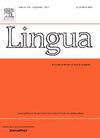The typology of degree marking
IF 1.3
3区 文学
0 LANGUAGE & LINGUISTICS
引用次数: 0
Abstract
Most languages involve up to seven degree constructions in which adjectives can occur: bare, intensified, mitigative, superlative, superior, inferior, and equative. In a sample of 157 languages, we classify and quantify the lexical, synthetic, and analytic marking strategies of each degree construction. From this classification, we derive an implicational hierarchy (Bare < Equative < Superior < Superlative < Intensified < Inferior < Mitigative) which predicts the relative markedness of individual degree forms. If a language employs a degree form for a particular position on the hierarchy, it will also exhibit a degree form that is equally or less marked for any position ranking lower. The hierarchy is motivated by two cognitive factors: firstly, by a discourse principle, which rates a subject characterized by an inferior/mitigative adjectival degree as pragmatically marked since it conveys information in an atypical manner, and secondly by a quantity (or informativeness) principle, which tracks degree forms as quantifiers with increasingly complex profiles. Finally, we introduce two new concepts, à priori and à posteriori hierarchies, and demonstrate that the degree hierarchy is à posteriori in nature.
学位标记的类型
大多数语言都有七种程度的结构,其中形容词可以出现:裸级、强化级、减轻级、最高级、上级、下级和等同级。在157种语言的样本中,我们对每个度结构的词法标记策略、综合标记策略和分析标记策略进行了分类和量化。从这个分类,我们得到一个启发的层次结构(裸 & lt; 等同的 & lt; 优越 & lt; 最高级 & lt; 加剧 & lt; 劣质 & lt; 镇静剂)预测个体的相对显著度形式。如果一种语言在层次结构中的特定位置使用学位表,那么它也会显示一个学位表,该学位表在排名较低的任何位置上都有相同或更少的标记。这种等级制度是由两个认知因素驱动的:首先是话语原则,它将具有低级/减轻形容词程度特征的主语评为语用标记,因为它以非典型的方式传达信息;其次是数量(或信息性)原则,它将程度形式作为具有日益复杂特征的量词进行跟踪。最后,我们引入了两个新概念,即先验层次和后先验层次,并证明了程度层次本质上是先验的。
本文章由计算机程序翻译,如有差异,请以英文原文为准。
求助全文
约1分钟内获得全文
求助全文
来源期刊

Lingua
Multiple-
CiteScore
2.50
自引率
9.10%
发文量
93
审稿时长
24 weeks
期刊介绍:
Lingua publishes papers of any length, if justified, as well as review articles surveying developments in the various fields of linguistics, and occasional discussions. A considerable number of pages in each issue are devoted to critical book reviews. Lingua also publishes Lingua Franca articles consisting of provocative exchanges expressing strong opinions on central topics in linguistics; The Decade In articles which are educational articles offering the nonspecialist linguist an overview of a given area of study; and Taking up the Gauntlet special issues composed of a set number of papers examining one set of data and exploring whose theory offers the most insight with a minimal set of assumptions and a maximum of arguments.
 求助内容:
求助内容: 应助结果提醒方式:
应助结果提醒方式:


